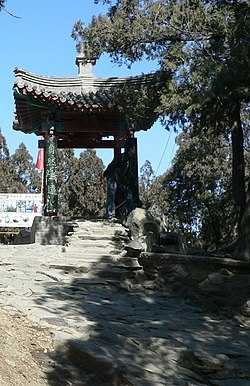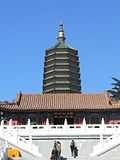Top Qs
Timeline
Chat
Perspective
Badachu
Urban park in Beijing, China From Wikipedia, the free encyclopedia
Remove ads
The Badachu (simplified Chinese: 八大处; traditional Chinese: 八大處; pinyin: bādàchǔ; also known as "Badachu Park") is a complex of monasteries located on the outskirts of urban Beijing, which means "Eight Great Sites" that refers to the eight Buddhist temples and nunneries scattered across the Cuiwei, Pingpo, and Lushi hills in Shijingshan District, at the foot of Beijing's Western Hills.[1]
This article may rely excessively on sources too closely associated with the subject, potentially preventing the article from being verifiable and neutral. (March 2023) |
Remove ads
Three Mountains
The north one is Hutou Mountain (虎头山); the south one is Qinglong Mountain (青龙山), and the middle one is Cuiwei Mountain (翠微山).
Cuiwei Mountain is also called Pingpo Mountain. It is the highest of the three mountains. It is the burial place of Princess Cuiwei.[who?] The mountain contains five temples: Sanshanan Nunnery, Dabei Temple, Longquan Nunnery, Xiangjie Temple, and Baozhu cave.[2]
Hutou Mountain means the head of a tiger. In the historical record, Hutou Mountain is also called Mingjue Mountain (名觉山). The mountain has two temples, Changan Temple and Lingguang Temple.[2]
Qinglong Mountain means green dragon. The east part of it is also called Lushi Mountain. According to legend, at the end of the Sui dynasty a monk named Lu Shi tamed two dragons and buried them in the mountain. The mountain also has the ruins of four more temples and a yard. The mountain has one of the Eight Temples, Zhengguo Temple.[2]
Remove ads
Gallery
- Treasure trunk pagoda at Lingguang Temple
- Entrance to the Dabei Temple
- Entrance to the Xiangjie Temple
- Paifang at the Baozhu Cave
- Lingguang Temple
Notes
References
External links
Wikiwand - on
Seamless Wikipedia browsing. On steroids.
Remove ads







